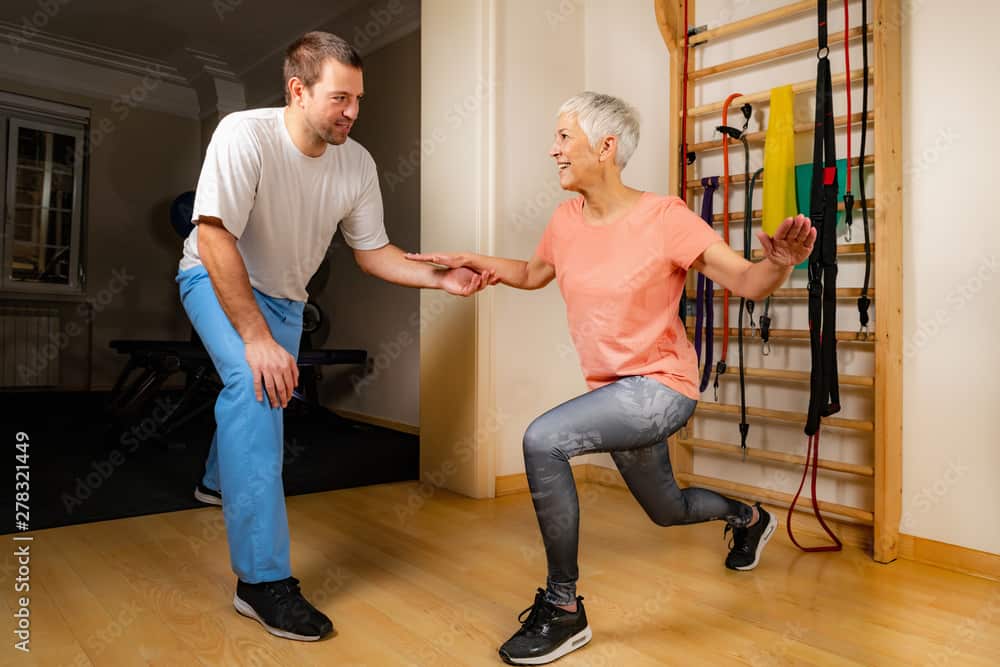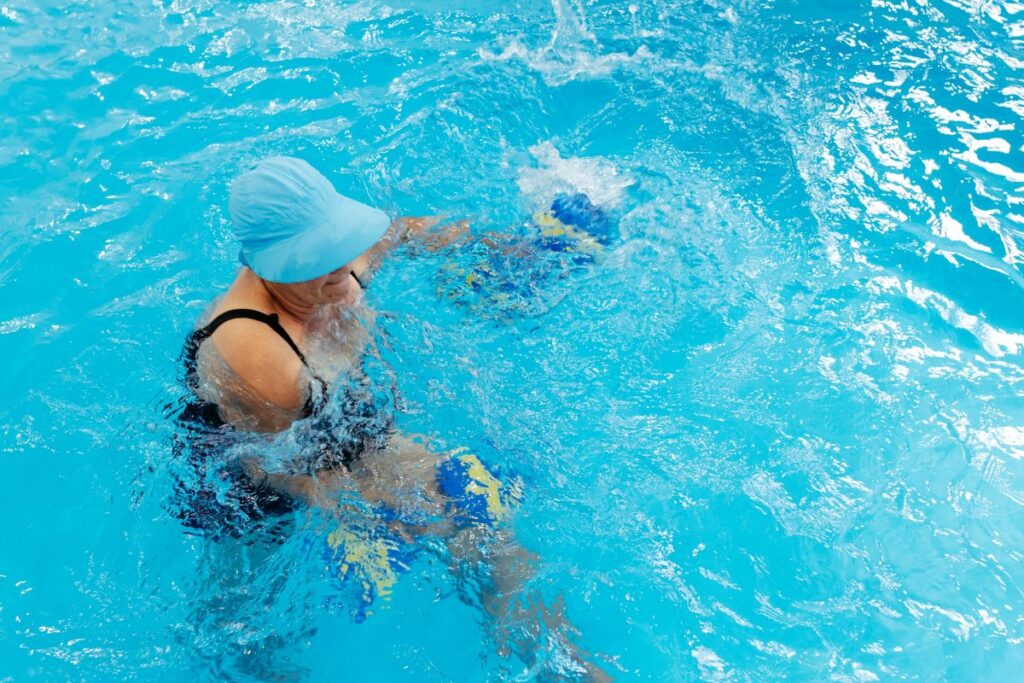Best Modified Lunges for Seniors: Easy Exercises to Stay Active
Updated 7/22/24
We all know that as we get older, keeping and/or building our strength and improving our mobility is super important.
Falls and injuries become a real issue for a lot of us.
We no longer bounce like we used to!
A good fall or injury can keep us down for days!
So, how do we stay strong and mobile?
You know what I’m gonna say …… by strength training, my friend.
There are many wonderful lower-body exercises that we can do, but I have found that unilateral (single) leg exercises like lunges are the most beneficial.
They are great for improving lower body strength and balance.
However, traditional lunges can be challenging for some of us older gals, especially if you have balance issues or knee or hip pain.
That’s where modified lunges come in.
It doesn’t matter if you’re a beginner or have been exercising for years, there’s a modified lunge that will work for you.
Stick around, and we will explore the most effective modified lunges that you can do to stay safe.

This post may contain affiliate links. As an Amazon Associate, I earn from qualifying purchases. This means I may earn a commission at no extra cost to you should you choose to make a purchase using my link.
Why Do Lunges?
Lunges target the quads, hamstrings, gluteal muscles (your butt), and calves, which are all important major muscle groups for mobility and stability.
They’re a unilateral exercise and, therefore, work both legs equally.
Plus, they aren’t complicated; even a few minutes a day can lead to huge improvements.
It’s best to start with a modified version of the lunge and slowly work your way up to the full version.
There are many modifications that can be made to lunges to make them easier and safer.
Don’t push yourself too hard, and always listen to your body. If you experience pain or discomfort, stop the exercise immediately.
READ MORE: Benefits of Lunges: 11 Benefits, Types, and More (healthline.com)
Best Modified Lunges for Seniors
Lunge exercises are perfect for anyone to do.
There are several ways to do lunges, so trust me, you can find the perfect lunge variation that works best for you!
I will explain different lunge modifications below.
So start where you are comfortable.
Remember that small tweaks can lead to huge benefits.
Pool Lunges
If you need to start a little slower and you have access to a pool, I would suggest starting in the water.
We are much more buoyant in water, and falls are no big deal!
Here’s how to do them:
- Stand in waist-deep water with your feet hip-width apart.
- Step forward with your right foot and bend your left knee, keeping your back straight.
- Hold the position for a few seconds, then return to the starting position.
- Repeat on the other side.

Assisted Stationary Lunges
If you’re just starting out, keeping it simple is key.
Stationary lunges or static lunges are beginner-friendly lunges.
If you have issues with balance or range of motion, then using support, like a chair or a wall, can be very helpful.
Also, you may want to start with a high lunge and not go as far when bending your front and back leg until you feel stronger.
We don’t want any falls!
To do this:
- Stand with one hand on the wall, or try standing next to or behind a sturdy chair.
- Place one hand or two hands resting lightly on the backrest.
- Stand with one foot forward and the other back.
- Then, bend both knees to lower your body without stepping forward.
- Keep your back straight and tighten your core muscles.
- Make sure that your front knee does not go past your front foot—this could cause some unnecessary knee pain.
- Stand back up without changing the position of your legs.
- Then, lower back down.
- Repeat x 10 and then switch legs.
Reverse Lunges
Reverse lunges are great for working on leg strength and balance.
Make sure that you continue to use the wall or a chair if your balance isn’t there yet.
Here’s how to do them:
- Stand with your feet hip-width apart and your hands on your hips.
- Step back with your right foot and bend your left knee, keeping your back straight.
- Make sure that your front knee does not go past your toes.
- Hold the position for a few seconds, then return to the starting position.
- Repeat on the other side.
Forward or Traditional Lunge
Okay, I will admit that I have heard from some people that a forward lunge aka traditional lunge, is easier than reverse lunges.
So, my advice is to try both and see what works better for you.
Again, holding onto a chair or wall if you need help with balance is a good idea.
To do this:
- Stand with your feet shoulder-width apart and your hands on your hips or at your sides.
- Take a large step forward with your right foot.
- Pull your abs in and keep the core tight.
- Begin bending your front knee and back knee into a lunge position.
- It’s very important to make sure that your front knee does not go past your toes.
- Lower your body until your back knee almost touches the ground (if this is difficult, only go as low as you can without falling or experiencing increased pain).
- Most of your weight should be on your front leg.
- Make sure that your back is straight and tall with a slight lean forward.
- Push off your back foot and return to the starting position.
- Repeat with your opposite foot.
Lateral Lunge
Once you master the forward and backward lunges, it’s time to move on to lateral or side-to-side lunges.
If you need to hold onto a chair or wall to do this exercise, do that.
With time and hard work, you will get stronger and have better balance, and then you can ditch the assist.
To do this exercise:
- Start in a standing position with your feet hip-width apart and toes forward.
- Place your hands on your hips.
- Shift your weight to the right foot and step to your right—be sure not to step too far.
- Bend your right knee with your back flat and your hips back.
- Keep your knee aligned with your foot, not outside the foot.
- Keep the left leg straight and your toes pointed forward.
- Push into your right foot to return to the starting position.
- Repeat on the other foot.
- You can alternate legs or do a set of 10-12 on one leg and then switch to the other leg – your choice!
To step up your lunges, you could add resistance bands or free weights to your workout.
You can hold free weights in one hand or both hands.
Holding small dumbbells during the lunge adds resistance and helps build muscle.
Always focus on controlled movements and good form.
READ MORE: Side Leg Exercises: Benefits And How To Tips For Seniors | Simply Aging Healthy
Safety Measures and Injury Prevention
Your priority should be staying safe and avoiding injuries.
The best way to do that is by paying attention to your form and knowing when to decrease the intensity of the exercise.
It’s also important to wear shoes that do not have a slippery sole, like sandals or slippers.
I recommend a good, supportive athletic shoe.
Be sure to do a good warm-up before you start exercising and a cool-down when you are finished.
READ MORE: Stretching Or Foam Rolling: Which Is Best? | Simply Aging Healthy

Spotting and Correcting Bad Form
If you don’t have proper form when doing lunges, you can cause extra strain on your knees and ankles.
Be sure that your knees do not extend past your toes and that you don’t lean too far forward.
Keep your back straight and shoulders back.
Go down only as far as you can tolerate.
If you start to experience any pain, you should stop immediately and try adjusting your posture.
Mirrors can be super helpful. This way, you can make sure that you are using good form.
If a mirror is not available, you could video yourself doing the exercise on your cell phone and play it back.
If you are still not comfortable with your form, getting a personal trainer could be very helpful for you.
When to Scale Back Intensity
As older adults, knowing our limits is so important.
Always listen to your body. If you have difficulty with doing 10 lunges, decrease to 3 and build up slowly.
It’s perfectly okay to decrease the number of reps or take longer breaks.
If you’re a complete newbie to lunges or just returning from a long break, start slow and limit your range of motion.
Remember to progress at your own pace.
Are Modified Lunges for Seniors Important?
Lunges are a must-try exercise for any woman over 60.
Why?.
Because they offer huge benefits like increased strength and muscle mass to keep us strong and independant.
However, if you are having trouble getting started due to knee pain or poor balance, modified lunges are an excellent option.
Even if pain or range of motion are an issue for you, modified lunges can still be done.
Just remember that consistency is super important to see the gains.
So, grab that chair or hold onto that wall, and let’s get started!
Let me know how you’re doing with the lunges.
If you have any questions, I would love to help!
